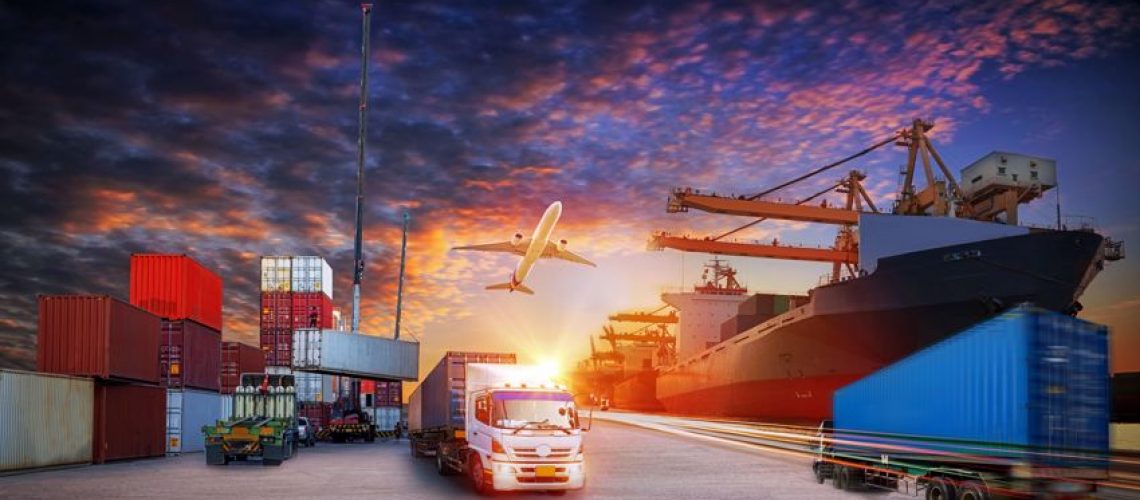Reliability in the supply chain — you want it for the sake of planning and managing an effective budget, one that will protect the bottom line. Your customers want it, too. They'll trust your business more, and be comfortable working with you in the future, if you offer a solid logistics experience.
Having such solid supply chain performance is especially important in today's era of e-commerce as a first option. It's never been clearer which companies can effectively manage their supply chain operations and which can't.
With all that said, providing effective logistics means managing multiple transportation options effectively. If problems arise anywhere in your freight and parcel shipping processes, the knock-on effects will be felt widely. Adding to the challenge, numerous potential risk factors could harm your operations at any given time.
A supply chain in the digital, global commerce era is a complex series of connections between companies. These links may prove fragile, and a lack of visibility into the links between your organization and its freight or parcel shipping carriers could make it hard to detect a problem before it causes serious logistical delays.
Anticipating and proactively managing supply chain risk factors are important tasks for any business today. This is all part of transportation spend management, and therefore a consideration for both your performance and budget. With the right mixture of risk mitigation strategy and supply chain management technology, you can excel at risk management and stay competitive.
What Are the Leading Supply Chain Risk Factors?
The first question to ask when counteracting supply chain risk is what kinds of issues might cause a breakdown. The bad news for your organization is that these problems can take many forms, some global in scale and others much closer to home.
Some examples of these sources of potential risk include:
- Global supply chain factors: World events can bring your logistics operations to a halt. During the global pandemic, companies quickly felt the struggle to acquire certain raw materials in a timely way as plants and ports around the world were forced to close or limit their operations. The years since 2020 have brought on other challenges — the war in Ukraine, for instance, has cut off many businesses' conventional sources for materials and manufactured goods.
These large-scale events don't just affect specific companies' supplier risk, although that doesn't mean every business will be affected by them equally. Firms that have a strong contingency plan and resiliency built into their transportation contracts will be better able to serve their partners and customers when a global shortage strikes.
- Localized and specific factors: It doesn't take a disease, a natural disaster, or a war to bring a company's supply chain to a halt. Supplier risk still applies at the individual level. Furthermore, if a business's freight or shipping partner suffers a setback, the knock-on effects can be severe. Internal difficulties at one of these organizations can lead to a failure to meet service level agreements, leaving businesses quickly scrambling for alternative arrangements.
The answer to small-scale supply chain risk is very similar to the response to global disruptions. Building highly redundant and resilient logistics operations is simply a sound practice today. This should be coupled with analytics and business intelligence (BI) to anticipate problems and respond to them.
Other risk factors split the difference between global supply chain events and local problems, and are worthy of mention. For instance, businesses may find their standard freight or shipping carriers have been temporarily shut down by a destructive but regionally contained natural disaster, like a hurricane, flood or tornado. Internal factors such as the threatened UPS strike could also affect specific partner organizations.
In short, there are a wide variety of elements capable of bringing down an entire supply chain, at least temporarily. The question, then, is what your organization is going to do about these issues.
The stakes are high — if you succeed in building out your risk and disruption prevention operations, you could provide a notably better experience than your closest competitors when times are toughest.
A lack of visibility can bring increased risk to your supply chain — learn how to counteract this issue.
What's the Importance of Supply Chain Risk Management?
The delays and shortages brought on by supply chain disruptions can leave your organization in a predicament, whether the problems happen upstream or downstream of your business.
It's simply logical: You're counting on your freight suppliers to provide goods or raw materials, and relying on your parcel shipping partners to put items in the hands of clients or customers. If any one of your transportation agreements breaks down for any reason, your business will lose important capabilities.
Two of the most common effects that come from supply chain problems include:
- Loss of profitability: A supply chain disruption that doesn't receive a swift, effective response can leave your business missing out on major profit opportunities. Lack of key materials for a manufacturer could stop the production line, with employees' salaries going to waste as they're unable to complete their work without the necessary goods. On the other end of the supply chain, a lack of effective parcel delivery may leave the business unable to sell its goods, either to stores or directly to customers, cutting off a source of income.
- Loss of reputation: While missing out on profits is easier to quantify in the short term, there's another form of damage that can be even more harmful over time: reputation loss. If clients or customers lose trust in your organization because you're unable to fulfill their orders — or do so in a slow, unreliable manner — they may defect to a competitor. When your supply chain partners can't live up to their agreements, due to either global or local disruptions, you can encounter this issue.
The key factor when it comes to either kind of damage comes from the comparison between your company and its competitors. The company with the best risk management practices will be able to bounce back most effectively from global issues and avoid localized problems before they cause too much harm.
If that best-equipped business is yours, you have an excellent opportunity to pick up customers who have been poorly served by less-prepared rivals. This means your risk prevention measures — from advance warning system creation to contingency plan design — have a direct impact on your bottom line.
Learn how accumulated risk factors can lead to overall issues for supply chains at local, regional, national and even global levels.
How Do You Stay Ahead of Supply Chain Risk?
You have a secret weapon in the battle against supply chain risk factors: data. Industries of all kinds have taken on infusions of BI and analytics in recent years, and transportation spend management is no different.
Today's supply chain contracts, invoices and even individual deliveries are all tracked digitally. That means there are more data points than ever available for companies to analyze, provided they have the right technology and strategies in place.
Modern analytics dashboards and visualization tools offer an unparalleled level of detail, allowing users to take in a company-wide supply chain risk analysis view or drill down to an individual shipment. This ability to take information in at any scale allows better decision-making, including preemptive choices that can limit risk exposure and prevent problems from causing damage.
Analyzing the performance of specific shippers, viewing the logistics situation in a particular region or zooming in on a selection of facilities can help leaders find the weak links in their supply chains. For example, issues meeting service level agreements can lead to corrections, or a lack of redundancy can receive a swift response.
Using BI allows your organization to be smart about its investments in supply chain resilience and risk mitigation strategy formulation. You can spend on replacing an unreliable carrier or finding an alternative sourcing option for a raw material or component that could be cut off by changing global conditions.
By modeling likely outcomes, you can plan ahead and think of ways to build a resilient supply chain that is still cost-effective. This is the crux of transportation spend management, empowering your organization to make choices that will protect the bottom line however possible. Amid today's plethora of possible disruptions, risk management absolutely falls into this category.
Optimizing your supply chain helps you prepare for any and all issues that may hinder your operations — figure out how it works.
What's Technology's Role in Supply Chain Risk Management?
The volume, variety and velocity of data flowing through organizations today are all higher than at any time in the past. This gives you plenty of opportunities to perform in-depth analytics and mitigate risk — but also means you'll need the right technology to get ideal results.
A transportation spend management system that connects every corner of your shipping profile, across every mode, is a key piece of logistics software today. This type of platform is a central pillar for your organization's entire supply chain management strategy to revolve around, with business intelligence coexisting with reports on carrier performance, as well as more granular shipment tracking.
Visibility is the keyword underlying both risk prevention and transportation spend management in general. If your logistics processes become too opaque, any risk mitigation efforts will be too heavily based on speculation or guesswork — or else fueled by manual, labor-intensive data analysis that can eat into productivity and profits.
If it's been years since your organization refreshed its technology, it's likely time to take another look. Systems dealing with data have made massive strides in recent years, and relying on legacy systems could make it difficult to lead your industry in risk preparation, or other key elements of transportation spend management.
Learn how companies are accessing more data than ever before and using this new content as fuel for better supply chain operations.
Manage Supply Chain Risk with FreightOptics
When selecting a transportation spend management system that can manage supply chain risks, software designed by logistics and supply chain experts will naturally align with your company's needs. That's a major reason why FreightOptics is such a powerful option — this proprietary solution has been produced by insiders with a keen, up-to-date knowledge of how transportation spend works.
The FreightOptics platform deals with every mode of transportation your company uses, in one location and requiring a single login. This makes it a more streamlined, unified technology experience than you can achieve by putting together a variety of other solutions.
FreightOptics supports both real-time data from all your shipments and the ability to dive deep into the numbers. You can formulate your risk management strategies and backup plans based on a comprehensive look at the numbers. Whether you're studying a specific region, resource or carrier, there are dashboards and visualizations to give you the inside story about risk exposure, ideal responses and more.
As an industry-leading transportation spend management system, FreightOptics provides a thorough suite of tools, including the BI and analytics features that will empower your supply chain risk analysis and mitigation efforts.
Contact us to learn how the FreightOptics platform gives you the knowledge you need when you're managing supply chain risk.




